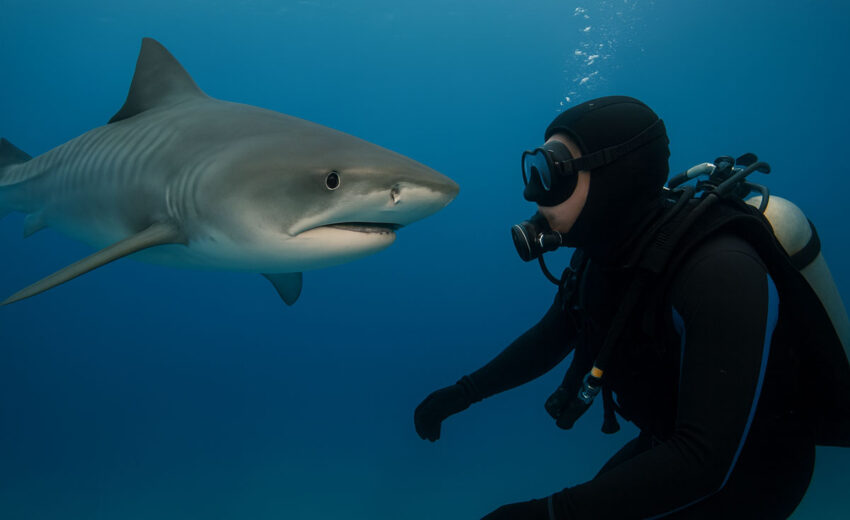Sharks are one of the ocean’s most misunderstood and magnetic creatures. For many divers, the chance to see — and sometimes swim alongside — these apex predators is a career highlight. Whether you’re a recreational diver chasing the thrill or a technical diver planning deeper encounters, knowing how to interact safely and respectfully with sharks ensures memorable experiences that protect both you and the animals. This long-form guide covers everything you need to know: preparation, gear, behavior, emergency protocols, legal and ethical considerations, and how to make the most of shark dives in Florida and beyond.
Why dive with sharks?
Shark encounters offer a powerful lesson in marine ecology. Watching a predator that has evolved for millions of years moves with efficiency and purpose can change the way you view the ocean. Beyond the thrill, shark diving delivers:
- Close-up education about predator-prey dynamics and ecosystem roles.
- Unique photo and video opportunities for divers and researchers.
- Economic incentives for local communities to protect sharks through tourism.
- The chance to support conservation by witnessing sharks in their natural habitat rather than in captivity.
If you’re in the U.S., Marine life diving Florida is a world-class opportunity for shark encounters — from coastal reef species to pelagic giants. For divers wanting to go further, Technical diving Florida can open access to deeper wrecks and offshore pinnacles where larger sharks patrol.
Know your sharks (and what to expect)
Different shark species have different behaviors, so learn which ones you’re likely to encounter:
- Nurse sharks — often docile, found resting on reefs and ledges. Approachable but treat them with respect.
- Blacktip and spinner sharks — fast swimmers common in warm, nearshore waters.
- Bull sharks — powerful and territorial; encounters often occur in murky or estuarine waters.
- Lemon sharks — often encountered in Florida’s shallow coastal waters.
- Tiger and great hammerhead sharks — less common but possible on offshore dives or deep pinnacles.
- Pelagic species (e.g., mako, thresher) — encountered offshore; technical and boat dives may be required.
On many Florida trips you’ll see a mix of reef-associated species and pelagic visitors. If you plan to expand from recreational to technical environments, learning about the habits of deeper-dwelling species is essential — this is where Technical diving Florida knowledge becomes valuable.
Training & certification: what you need
Before you deliberately seek shark encounters, make sure your diving skills match the environment:
- Open Water: Foundation for safe diving. Comfortable buoyancy and equalization are musts.
- Advanced Open Water: Useful for deeper reef or drift dives where sharks may be present.
- Drift, Deep, and Peak Performance Buoyancy specialties: Help you maintain position without startling wildlife.
- Rescue Diver: Builds situational awareness and response skills that are invaluable in crowded or dynamic shark dives.
- Technical certifications: Required for dives beyond recreational limits. If your encounter requires penetration of wrecks or deep offshore pinnacles, take Technical diving Florida courses that cover decompression, gas management, and advanced equipment.
Work with dive operators experienced in shark encounters — they’ll ensure briefings and protocols match the species and environment.
Gear checklist for shark encounters
Your equipment should be reliable and suited to the specific dive:
Essential gear:
- Properly serviced regulator and BCD.
- Exposure protection appropriate for depth and water temperature.
- Primary dive computer and a backup.
- Cutting tool and SMB (surface marker buoy).
- Underwater slate or signaling device.
For technical dives:
- Redundant gas systems (twinsets or stage cylinders).
- Decompression planning tools and mixed gas training if using nitrox/trimix.
- Reels, lift bags, and robust back-up lights.
Optional but helpful:
- Camera housing with strobes (avoid bright, erratic lights that may startle animals).
- Shark shield or personal electronic deterrent — note these are controversial and not a substitute for good behavior.
- Stick or pole for maintaining personal space (many operators prohibit poking or touching animals; use only if trained and permitted).
Pre-dive planning & briefings
A thorough pre-dive briefing is non-negotiable:
- Species profile — what sharks you may see, typical behavior, and space needs.
- Site layout — entry/exit points, depths, currents, hazards.
- Buddy plan — roles, maximum distance between buddies, and emergency signals.
- Encounter protocol — how to approach, where to position, and when to slowly ascend.
- Emergency procedures — nearby decompression chamber, surface support, and first-aid supplies.
Operators often set rules: no chasing, no splashing, and no feeding unless it’s a controlled, research-led baiting where safety protocols are strict. Follow the operator’s instructions; they know local habits and animal personalities.
Best behavior around sharks
How you act during an encounter can make the difference between a calm, cinematic meeting and a stressful situation:
- Stay calm and controlled. Slow movements are less likely to be perceived as a threat or prey behavior.
- Maintain neutral buoyancy. Don’t thrash or touch the bottom — avoid presenting yourself like prey.
- Keep your hands close. Avoid reaching out; touching can transfer harmful bacteria and stress the animal.
- Face the shark when possible. Predators often study faces; moving away suddenly could trigger curiosity or a follow response.
- Respect personal space. Let the shark approach; don’t swim directly toward it.
- Avoid bright, jerky lights. Flashy strobes are okay for photography, but erratic lighting may provoke reaction.
- Stay with your group and buddy. Sharks are less likely to approach groups than isolated divers.
If the shark shows signs of interest (rapid approach, vertical posture), maintain composure, slowly back away while keeping eye contact if possible, and signal your buddy and dive leader.
Baiting and chumming: pros and cons
Some dives use bait to attract sharks. This increases sighting chances, but there are trade-offs:
Pros:
- Higher density and predictability of sightings.
- Useful for scientific observation and photography.
Cons:
- Can condition sharks to associate boats or people with food.
- May alter natural behavior and risk habituation to humans.
- Some jurisdictions regulate or prohibit baiting, especially in sensitive areas.
If participating in a baited encounter, ensure it’s run by reputable operators who follow ethical and legal guidelines and use methods that minimize behavioral conditioning.
Photography & videography tips
Capturing a shark on camera is thrilling — do it responsibly:
- Use a wide-angle lens to get close without crowding.
- Keep strobes steady and avoid sudden flash bursts.
- Frame the shark with environment to tell a story (reef, wreck, current line).
- If filming, move slowly and anticipate the animal’s path rather than chasing it.
- Review your footage after the dive — learn how your behavior impacts the animal.
Remember: no photo is worth risking a diver’s safety or the shark’s welfare.
Emergency response & first aid
Even in low-risk encounters, be prepared:
- Know how to handle bite or puncture wounds — apply pressure for bleeding, seek immediate professional medical care, and clean wounds to prevent infection.
- Be familiar with local emergency evacuation and recompression chamber locations for decompression incidents.
- Maintain a calm surface protocol: have surface support and communication devices on the boat (VHF radio, cell, satellite as needed).
A Rescue Diver course and refresher training in first aid/CPR are excellent investments for frequent shark divers.
Legal, ethical, and conservation considerations
Shark populations worldwide face threats from overfishing, bycatch, and habitat loss. Ethical shark diving helps conservation:
- Support operators who contribute to research and local conservation efforts.
- Follow “look but don’t touch” policies to minimize stress and disease transfer.
- Avoid operators that encourage irresponsible feeding or harassment.
- Respect protected area rules and seasonal closures — many shark aggregations are protected.
When diving in Florida, abide by state and federal marine regulations intended to protect both divers and marine life. Responsible tourism turns shark encounters into tools for education and protection.
Specific notes for Florida divers
Florida is a top spot for shark encounters and marine biodiversity. If you’re searching for experiences, consider both nearshore reef and offshore boat trips. Keep the keywords in mind: Marine life diving Florida is an umbrella for reef, wreck, and coastal encounters. Meanwhile, Technical diving Florida opens more advanced possibilities — deep wrecks and bluewater pinnacles often host larger, more pelagic shark species. Whether you’re on a reef with nurse sharks or on a technical decompression dive near deep structures, a local, experienced operator is invaluable.
If you plan to pursue Technical diving Florida experiences:
- Get locally specific training for currents, sea conditions, and emergency infrastructure.
- Use proper gas mixes and redundant systems.
- Coordinate with seasoned technical operators who understand local pinnacles and deep wreck behavior.
Choosing an operator: red flags & green flags
Green flags (good signs):
- Clear, species-specific briefings.
- Emphasis on conservation and no-touch rules.
- Evidence of permits and safety certifications.
- Good crew-to-diver ratios and surface support.
- Transparent protocols for baiting/chumming (if used).
Red flags (avoid):
- Encouraging close contact or touching animals.
- Poorly maintained equipment or vessels.
- No clear emergency plan or communication.
- Operators that prioritize photo ops over diver safety and animal welfare.
Final checklist before your shark dive
- Confirm your certifications and recent experience match the dive profile.
- Check local rules and seasonal advisories.
- Verify operator safety records and conservation commitments.
- Pack redundant air options if required for technical profiles.
- Bring a dive log and camera, but keep ethical behavior front and center.
Conclusion
Shark encounters are among the most humbling and exhilarating experiences a diver can have. With respect, preparation, and a pledge to conservation, you can safely observe these extraordinary predators while minimizing impact. Whether you’re scouting the nearshore reefs for nurse and lemon sharks during Marine life diving Florida trips or planning deeper projects that require Technical diving Florida expertise, the keys are training, situational awareness, and choosing responsible operators. Dive smart, remain calm, and let the ocean teach you — the memory of a respectful shark encounter will stick with you for a lifetime.


